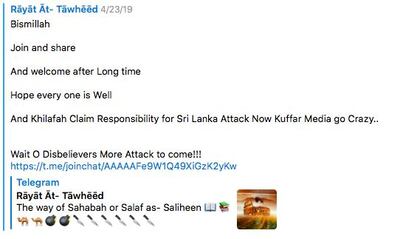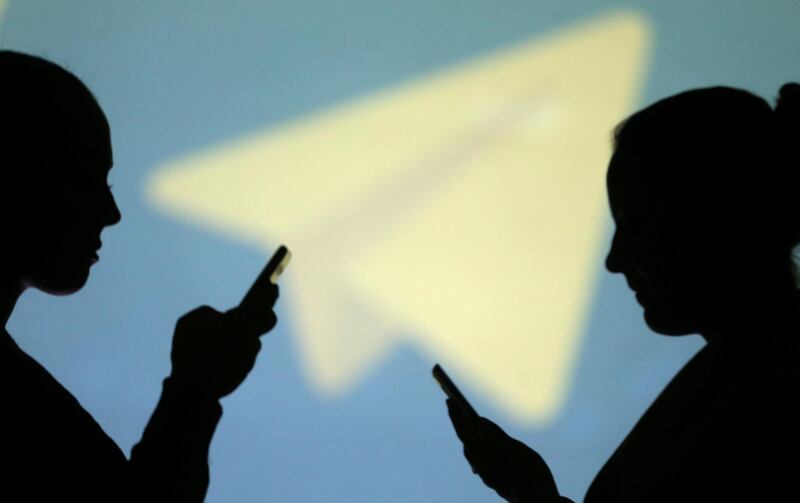ISIS supporters on Telegram use emojis and memes to create their own internet subculture, mixing images related to death and violence with more widely popular themes such as cats, a researcher has found.
Chelsea Daymon, a terrorism researcher at the American University’s School of Public Affairs, observed pro-ISIS groups on the encrypted messaging app for two months, and discovered members used emojis and gifs in their messaging.
Telegram has become a popular channel for extremists to communicate after crackdowns on terrorism on larger platforms such as Facebook and Twitter.
Features such as the ability to communicate without revealing a phone number and self-destruct timers on messages make it ideal for operating undetected, the Programme on Extremism at George Washington University reported this month.
“English-speaking ISIS supporters exploit Telegram’s suite of features to communicate with like-minded supporters across the world, disseminate official and unofficial ISIS media, and provide instructional material for operations,” wrote the report’s authors, Bennett Clifford and Helen Powell.
“Research has shown that using emojis in posts or even texts, like we do every day, will help the reader understand the clarity,” Ms Daymon told the Terrorism and Social Media Conference in Swansea.
"Emojis can actually speak for themselves within a post."
Online communities often use particular types of gifs and emojis to foster a sense of community. Beyonce fans post the bee emoji and fans of TV shows post gifs of their favourite moments.

“We all have our own culture, whether it's from a country you come from or a group we’re in or a university we’re a part of. Culture really forms a strong basis of identity,” Ms Daymon said.
This is also true of pro-ISIS groups on Telegram, who use tools of the internet including gifs, memes and emojis to create a shared culture.
Popular choices include the obvious such as knife, bomb and explosion emojis, but also the palm tree, smiley face and a hand with the index finger pointing up.
Ms Daymon calls this last emoji the takbir finger – a symbol used in the real world by ISIS fighters to mean there is only one God.
She showed the audience screenshots of Telegram posts announcing attacks or new content channels with accompanying emojis.
Telegram has been criticised for not acting fast enough to identify and block ISIS and other extremist groups from its platform.
In February, the Counter Extremism Project said six years after the app’s founding, it remained “a terrorists’ platform of choice for the dissemination of online extremist content”.
“The messaging application’s public-facing and private components are essential in allowing extremists the ability to propagate themselves online,” project researcher Joshua Fisher-Birch said.
“Telegram has for years faced criticism for the flagrant misuse of their platform, and the ease with which ISIS content is continuously found shows that they are not serious about dealing with the issue.”
The company says it is taking action against terrorist groups. So far this month, it has banned 6,029 terrorist bots and channels.
But activity within secret groups is proving harder to curb and it sticks doggedly to free speech principles.
“While we do block terrorist bots and channels, we will not block anybody who peacefully expresses alternative opinions,” the site’s frequently asked questions section reads.
ISIS-supporting Twitter users are also fond of emojis, said Mohammed Al Darwish, a researcher from M&C Saatchi World Services.
Mr Al Darwish analysed 221 ISIS "fanboy" Twitter accounts disseminating a particular piece of propaganda over three days, amounting to 3,311 tweets.
Many of these contained emojis, he said, with directional arrows, fire, camera and laughing face emojis being popular choices.
Ms Daymon also discovered what she calls a "softer side" to the pro-ISIS groups on Telegram.
“There is a very huge theme of cats and chocolate,” she said. “I mean, we all love cats and chocolate.
"And if you think about it, a lot of us tend to go to the internet for a silly cat videos and things. So why not ISIS supporters as well?”
But some of the groups with cat names or pictures contained gruesome pictures and gifs of violent acts such as beheadings.
The emojis and other tools used were to further the main themes of ISIS culture online, which Ms Daymon identified as brotherly love, glorifying fighters, victimhood and revenge, martyrdom, embracing terrorism and supporting the state of ISIS.
"Supporting the state has been a big thing, especially with the loss of territory," she said.
"So this idea that, 'Yes, we've lost a territory for awhile but we're not gone. We will continue on.
"'And even though we don't have the actual physical state, the idea still exists'."








